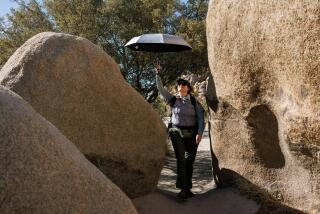Keeping Infection at Bay in the Back Country
- Share via
Despite the high cost of gasoline, the National Park Service expects nearly as many visitors this summer at its parks, recreational areas and other facilities. “People book far ahead,” says Butch Street, chief of the statistical branch of the National Park Service. “Gas prices won’t slow them down.”
In June, July and August 2000, the park service tallied more than 8.3 million overnight stays.
Campers, hikers and backpackers hoping to stay healthy and safe should focus on three areas, says Holly Bundock, a park service spokeswoman. They should heed the quality of drinking water and be aware of the risks of Lyme disease, which is transmitted by infected deer ticks, and hantavirus, transmitted by rodents.
Water from park taps is treated and purified, Bundock says, but “we do encourage everybody to treat their water when they are in the back country.”
Water from rivers and lakes can expose hikers and campers to waterborne diseases. Common ailments resulting from drinking tainted water in the wilderness include giardiasis, an intestinal infection caused by a parasite.
What’s the best way to purify water in the wild? You can boil it for one minute (three minutes at altitudes of 6,562 feet or more), according to the federal Centers for Disease Control and Prevention. Or you can use chemical agents or portable water filters and purifiers.
A comparison of chemical agents, purifying and filtration systems and hand-pump filters to purify water taken from a river near Paris was reported in the Journal of Travel Medicine earlier this year. The best systems, the French researchers found, were three hand-pump filters: Katadyn Products’ MiniCeramic, General Ecology’s First Need Deluxe and SweetWater’s WalkAbout. These removed 99.9% or more of viable bacteria, and no E. coli (a common infection source) were detected after use.
(Filters that remove microorganisms rather than chemically treating them do not have to be registered with the Environmental Protection Agency. For questions on filters and water purification, call the National Antimicrobial Information Network, an EPA-funded information line, at [800] 447-6349, weekdays 7:30 a.m. to 4:30 p.m. Pacific time.)
Another potential concern is Lyme disease, which can cause rash and fever, arthritis and neurological symptoms such as facial palsy. It’s often mistakenly thought of as an East Coast problem because that’s where the disease was first identified (in Lyme, Conn., in 1975). But visitors to parks on the West Coast and in North Central states are also urged to be aware of the hazard, according to the National Park Service.
Visitors are advised to avoid tall grass and brushy areas. Tucking pants into boots or socks and shirts into pants can help reduce the chance of a tick attaching to the body.
Outdoors enthusiasts might also ask their doctor about a vaccine, LYMErix. Three doses are given over a 12-month period for maximum effectiveness, according to manufacturer GlaxoSmithKline.
Hantavirus has been detected in deer mice in Channel Islands National Park, according to the National Park Service, and some locations on the mainland. The disease causes flu-like symptoms and is potentially fatal. Hikers and campers should avoid contact with rodents, prevent entry of mice into tents and keep food and drink in rodent-proof containers.
*
Healthy Traveler appears twice a month.
More to Read
Sign up for The Wild
We’ll help you find the best places to hike, bike and run, as well as the perfect silent spots for meditation and yoga.
You may occasionally receive promotional content from the Los Angeles Times.






